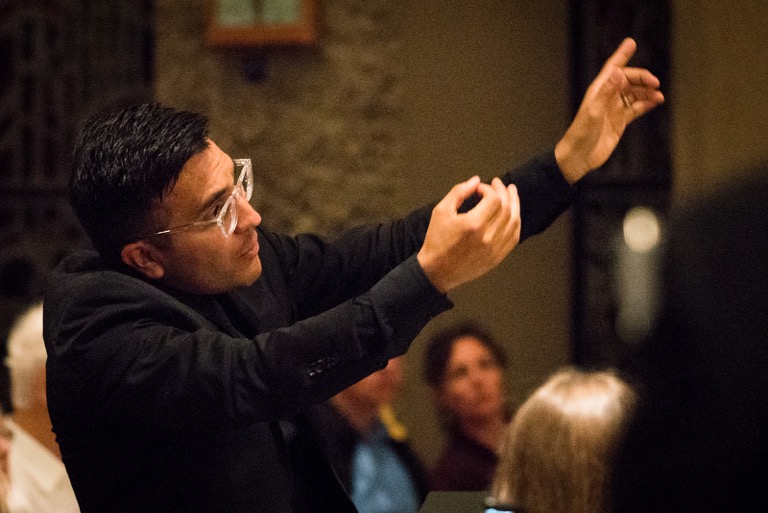Bach Collegium San Diego’s Stirring J.S. Bach ‘Christmas Oratorio’
Ruben Valenzuela’s Bach Collegium San Diego (BCSD) gave an electric performance of J. S. Bach’s Christmas Oratorio Friday (December 14) in the capacious sanctuary of the First United Methodist Church of San Diego. Sung in German by a strong 19 member chorus, accompanied by a fleet 25-piece period instrument ensemble, and guided by Artistic Director Valenzuela’s acute sense of Baroque period performance practice, this concert brought us amazingly close to Bach’s musical world.

Ruben Valenzuela [photo (c) Gary Payne]
What sets the Bach Collegium chorus apart from most other American choral ensembles is the way it stresses the natural strong accents of its cleanly articulated German text to animate and excite the musical texture. Combined with Valenzuela’s penchant for sprightly tempos and the parallel crisp articulation and short phrasing of the orchestra, the energy of these exultant movements is a wonder to experience. And it is the reason I will take the Bach Collegium’s 19 choristers singing a bracing “Jauchzet frohlocket” topped with the liquid brilliance of natural trumpets over 150 typical choristers barking out the “Hallelujah” chorus accompanied by a symphony orchestra. You know, that painfully overworked chorus from that not-a Christmas-oratorio by that celebrated German Baroque composer who defected to England.
In addition to exuberant movements, the BCSD chorus gave warmth and spiritual intensity to the meditative chorales that interpret to the congregation the dramatic events in these cantatas, chorales such as the Advent hymn “Wie soll ich dich empfangen” and the Nativity carol “Ich steh an deiner Krippe hier.” Valenzuela gave the familiar “Bricht an, o schönes Morgenlicht”—which is still sung in English-speaking congregations as “Break forth, O beauteous heavenly light”—a subtle but dramatic slow crescendo that tellingly evoked a majestic sunrise.
I wish that I could praise the team of vocal soloists with equal enthusiasm. Tenor Jason McStoots proved an outstanding Evangelist, the role Bach uses to narrate the cantatas’ Biblical stories of the shepherds, the adoration at the manger, the visit of the Magi and their encounters with Herod. McStoots’ vivid enunciation and acute sense of the text’s musical cadence was exemplary, and I never tired of his declamation. Baritone Paul Max Tipton displayed his fluent command of challenging fioritura, especially in his signature aria “Grosser Herr, o starker König,” where his stylish ornamentation was matched by First Trumpet Josh Cohen’s glistening lip trills. But when it came to brilliant soaring phrases, no singer was Cohen’s match.
The bright edge and clarity of countertenor Jay Carter’s upper range added welcome urgency to his aria “Bereite sich, Zion,” and he sang with compelling ardor in one of Bach’s typical question-and-answer ariosos with the chorus “Wo is der neugeborne König?” The fluency of soprano Melanie Russell and mezzo-soprano Janelle DeStefano was never in doubt, but I thought their voices were too small for the vast space of First United Methodist Church. I fear that Russell’s slight angelic proclamation to the shepherds would not have gained their attention, and in DeStefano’s lullaby aria “Schlafe, mein liebster,” the orchestra too easily overpowered her.
Although this concert presented only four of the six cantatas Bach complied in his Christmas Oratorio—Valenzuela chose cantatas 1, 2, 5, and 6–the orchestra still turned out an amazing amount of cogent, stylish playing, from the warm glow of the second cantata’s murmuring Sinfonia to the stirring, brassy flourishes of the closing chorale. We do not know if Bach ever presented his Christmas Oratorio in one setting: in its 1734 debut each of the six cantatas played in two different churches on different days over the 12-day Christmas to Epiphany holy season.
Kudos to the unfailing lyrical brilliance and accuracy of the trumpet section: in addition to Cohen it included Melissa Rogers and William Harvey, and it was eloquently undergirded by timpanist Maury Baker. Obists Marc Schachman and Michael Dupree worked together as a stunning team, and when called to execute the labyrinthine solo parts Bach lavished on the oboe, they rose to the occasion with sterling sonority and abundant grace. We have learned to count on BCSD for a nonpareil continuo section, anchored by harpsichordist Michael Sponseller—he is also BCSD’s Associate Music Director—and he never disappoints. He adds the occasional tasteful flourish just to remind us that he in never on auto-pilot! Cellist Heather Vorwerck and violone virtuoso Shanon Zusman have served with equal finesse in the continuo group, and for this concert theorbo expert Simon Martyn-Ellis added the piquant color of his instrument to brighten the continuo texture.
Valenzuela, of course, stands at the center to pull all of these forces together in a short amount of time to create an exciting period music adventure such as Bach’s Christmas Oratorio. He is the center of planning and the center on the podium, where his unfailing, rugged but never flashy direction enlivens and enlightens measure upon measure.
This concert by the Bach Collegium San Diego was presented on Friday, December 14, 2018, at the First United Methodist Church of San Diego, 2111 Camino del Rio South, San Diego. The concert will be repeated on Saturday, December 15, at the Greek Orthodox Church in Cardiff.

Ken Herman, a classically trained pianist and organist, has covered music for the San Diego Union, the Los Angeles Times’ San Diego Edition, and for sandiego.com. He has won numerous awards, including first place for Live Performance and Opera Reviews in the 2017, the 2018, and the 2019 Excellence in Journalism Awards competition held by the San Diego Press Club. A Chicago native, he came to San Diego to pursue a graduate degree and stayed.Read more…

Hmmmm. Never thought of Haendel as a defector. Was Haydn also?
No; Haydn stayed with the same noble family for most of his career, and was a staunchly loyal subject, refusing to even grant Napoleon a visit when the French had occupied Vienna!
By he did decamp toEngland, though he returned.